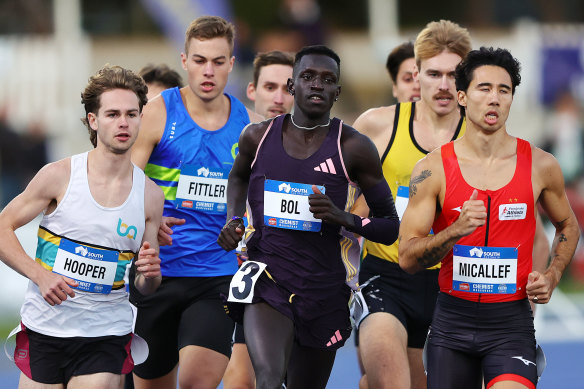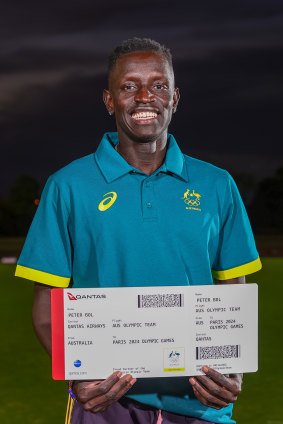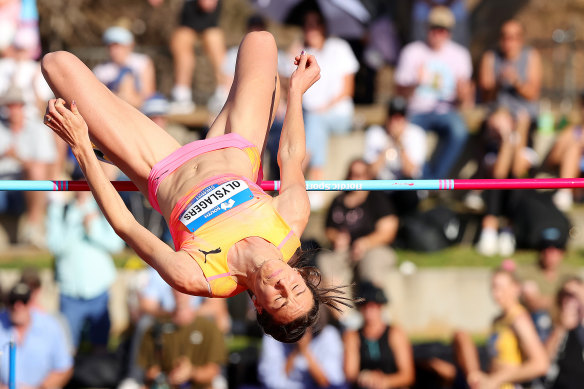He’s been wrongly accused, temporarily banned, and sidelined by a pesky hamstring injury. But Peter Bol is not only “thrilled” to be back on the Australian team for Paris 2024; he also sent a warning that he is there to win gold.
It’s been a bizarre three years between Games for the 30-year-old 800-metre runner, who was among the first athletes named on the Olympic team after the national athletics championships.

Peter Bol was pipped at the nationals but says he’ll peak for ParisCredit: Getty Images
Exonerated after a months-long investigation by Sport Integrity Australia, which followed a provisional suspension that resulted from a misread drug test, Bol has since battled form and injury issues but believes he can cut a second off his personal best in this Olympic year.
“It was great to be named in the team here in Adelaide. I’m thrilled to be going to my third Olympics. I can’t wait for Paris,” Bol said after being named in the team for the 800 metres in Paris.
“I think I’m in my best shape. I can take anyone and I can’t wait to give them my best later on this year. I’m pretty sure I will be in 1:43 shape this season, for sure.”
If Bol can deliver on that projection he will be right in the mix for medals in Paris. In Tokyo he won his semi-final in a personal best 1:44:11, then missed the medals by .53 seconds with a gutsy run in the final that captured the attention of an Australian public locked down by COVID.
That he was chosen in the first tranche of 14 athletes for Paris is a stunning turnaround.
Building back from a hamstring tendon injury, the former national record holder, was beaten at the national championships in Adelaide on Sunday by emerging talent Luke Boyes who ran 1:44.73. The winning time was just 0.03 seconds outside the Olympic qualifying mark and immediate selection with Bol on the team for Paris.
For context, the gold medal was won in Tokyo – admittedly in a relatively slow race – in a time of 1:45.06 and Bol ran 1:45.92 to come fourth. The time just to qualify for Paris is quicker than the gold medallist ran in Tokyo.

Peter Bol is back on the Olympic team after a turbulent three years since Tokyo.Credit: Getty Images
What was clear from the nationals was that Bol was nearing a return to his best and Boyes will almost certainly make the team, possibly along with Peyton Craig who came third at nationals. It also suggests Australia’s 800-metre runners are not only competitive but can challenge for medals.
“This race prepares you for the Olympic Games and the other races I’ve been running in previous years were almost too easy, and now you have the likes of Luke Boyes who can win at 1:44 mins leading, Peyton Craig at the back. That’s what we want in Australia. We have it in the 1500, now we have it in the 800.”
In the high jump, Olympic silver medallist Nicola Olyslagers has taken the view that while she is focused on winning gold she also wants to break the world high jump record of 2.09 metres set by Hungarian jumper Stefka Kostadinova in 1987.
Olyslagers has decided to abandon incremental height increases once she has a title or medal secured.
On Sunday she won the national title with her jump of 2.01 metres and immediately raised the bar to 2.06 metres, well above her own national record of 2.03 metres.
“You just need to put it up to the height that you desire to jump, don’t step stone it. So after 2.01 I went, well, I really believe 2.06 is in there,” Olyslagers said.

Nicola Olyslagers won the national title and wants to take down the world record.Credit: Getty Images
“So I just bypassed PBs because, ultimately, I want to jump high and you can’t jump high unless you’ve attempted [it].
“I thought, how is it possible that it’s been 37 years since a woman’s jumped over 2.09 metres? You know, how long is it? I recognised that when she was jumping 2.09, someone was jumping 2.07 right next to her. And so if you don’t have the luxury of that, you have to do big, bold things which most high jumpers don’t want to do.
“So I’m just learning how to be outside my comfort zone and push myself to do things and not settle for anything less than my best. I don’t think I know what my best is and that excites me.
“I want to do a personal best [in Paris] and I want to do a big one and I recognise if I want to do that the emotions of medals and things can steal that.”
For Olyslagers’ rival, former world champion Eleanor Patterson, Adelaide provided “a step in the right direction” as she returns to being competition ready after a break last year.
“It wasn’t necessarily a pretty scorecard,” she said after clearing 1.95 metres. “I’m happy with the progress.”
News, results and expert analysis from the weekend of sport sent every Monday. Sign up for our Sport newsletter.